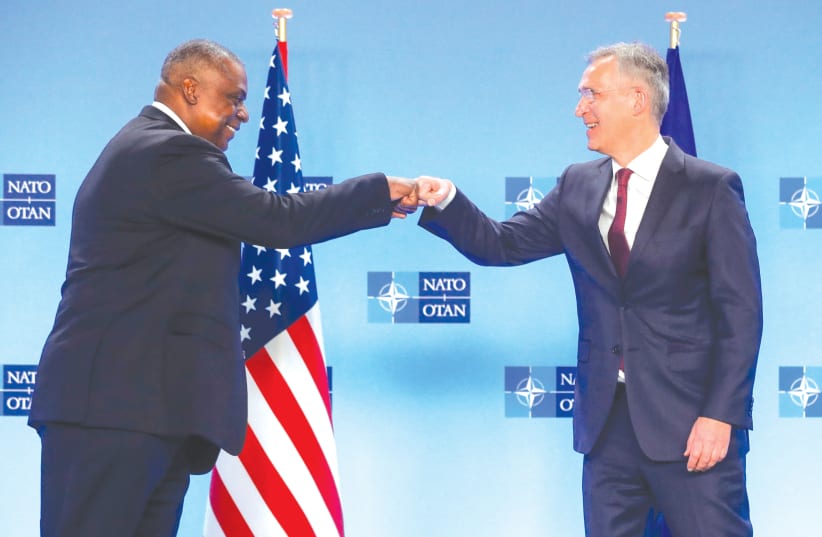China has recently joined Russia’s opposition to NATO expansion, drawing a parallel with the growing rapprochement between Beijing and Moscow. This reflects the tendency of both countries to work together to resist pressure from the West.
China’s attitude toward NATO is not surprising, as relations between the two sides have escalated dramatically in recent years. In their recent meetings, NATO leaders have repeatedly expressed concern about China’s growing ambitions, saying that they challenge the foundations of the international system.
Beijing urged NATO to view China’s growth rationally and not to exaggerate the Chinese Threat theory. “We do not pose systemic challenges to any country, but we would not sit idle if anyone is to pose systemic challenges to us,” China said.
Subsequently, NATO Secretary-General Jens Stoltenberg tried to tone down the alliance’s position: “We’re not entering a new Cold War and China is not our adversary, not our enemy.” But, he added, “We need to address together, as the alliance, the challenges that the rise of China poses to our security.” Although, some European experts believe NATO’s posture toward China lags behind that of the US.
They believe that the United States is taking advantage of NATO’s desire for a new identity and new goals to ensure its survival in the 21st century and to focus the alliance on the Indian and Pacific Ocean region. NATO says it cannot ignore reports of close and growing ties between Beijing and Moscow, as opposed to what it calls China’s rising power.
All of these issues are current in the strategic thinking of the alliance, whose military doctrine, adopted in 2010, does not view China as a potential threat. However, NATO’s position is gradually changing. It is expected that the revision of NATO’s current strategic concept to address the new threats in space and cyberspace will include items related to China.
At their last summit, NATO leaders noted that China’s stated ambitions and continued behavior pose a challenge to the foundations of a rules-based international order and to NATO’s security-related areas.
NATO’s look at China began in 2019, when the final declaration of the London summit stated, for the first time in NATO’s history, “China is coming closer to us. We see them in cyberspace, we see China in Africa [and] in the Arctic, but we also see China investing heavily in our own critical infrastructure and try to control it.” He added, “We need to respond together, as an alliance.”
China’s growing influence in international politics presents opportunities and challenges that NATO must address together, as an alliance, notes NATO’s March 2021 annual report. The following are some aspects NATO is concerned about.
NATO has adopted an 18-point strategy that the secretary-general calls a response to authoritarian regimes racing to develop new technologies. As well, he stated that future conflicts will be solved, not only with bullets and bombs, but with Big Data and NATO countries must maintain their technological superiority.
The common denominator shared by Washington and the rest of NATO is deep concern about China’s vast development of AI-equipped weapons systems. The US has reached out to its most prominent chiefs in major technology companies, who have released a report with important advice on how to counter China’s ambitions.
According to the report, senior military officials have warned the US could lose its military and technological superiority in the coming years if China beats them to the punch in developing AI weapons systems. What is dangerous about US strategic assessments is that they link US military might to excelling at AI. A recent official White House report states that a competitor capable of outperforming the US in long-term chip development and production, or preventing it from fully claiming those segments, will have the upper hand in any war field. President Joe Biden ordered a review of the US chip manufacturing sector.
He pledged to support a $37 billion congressional program to promote domestic materials production. In turn, China pledged to provide strong support to Chinese chip makers. The country aims to produce 70% of the chips it uses by 2025.
According to a report by the Center for a New American Security, the research arm of the US intelligence community, China is no longer technologically inferior to the US; in fact, it is competitive in the field of AI and has the potential to overtake the US.
NATO has positioned itself as a party in this bitter rivalry between the US and China, although there are large areas of common interests between China and European NATO member states. Some members are participating in China’s Belt and Road Initiative, and under this initiative, China is investing heavily in infrastructure in the Balkans and Southeastern European countries.
However, no matter how great European interests toward China may be, they will not match the common interests between the US and China. In 2020, trade between the two countries reached about $586 billion, despite the raging trade war and the impact of the COVID-19 epidemic. Trade statistics between the EU (mostly NATO members) and China cannot be ignored.
China has overtaken the US for the first time to become the EU’s largest trading partner, in 2020. According to Eurostat, EU trade with China amounted to $586 billion, equal to the volume of trade between the US and China, and is about $31 billion more than European trade with the US.
The extent of mutual interests makes it difficult to dismiss them suddenly, making it necessary to gain an understanding of all the variables involved in international strategic interactions to shape the post-COVID-19 world order.
The writer is a UAE political analyst and former Federal National Council candidate.

